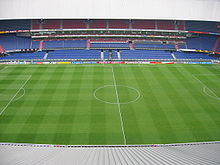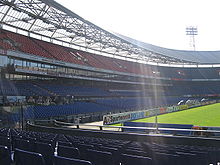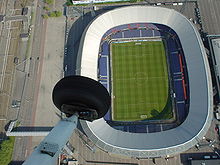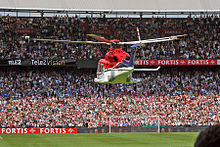- De Kuip
-
Stadion Feijenoord de Kuip 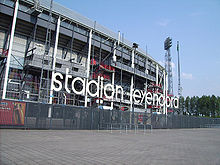
Full name Stadion Feijenoord Location Rotterdam, Netherlands Built 1935–1937 Opened July 23, 1937 Renovated 1994 Architect Leendert van der Vlugt
Broekbakema (renovation)Capacity 51,577 (49,000 for KNVB matches) Website dekuip.nl Tenants Feyenoord (Eredivisie)
KNVBThe Feijenoord Stadion, better known by its nickname De Kuip (Dutch pronunciation: [də ˈkœyp]) (the Tub), is a stadium in Rotterdam, Netherlands that was completed in 1937. The name is derived from the area "Feijenoord" in Rotterdam, and from the club with the same name (although the club's name was internationalised to Feyenoord in 1973).
Capacity at completion: 64,000. Maximum capacity: 69,000 (1949). Present day capacity: 51,177 (49,000 for KNVB matches).
It is the home stadium of football club Feyenoord, one of the traditional top teams in the Netherlands. It has also long been one of the home grounds of the Dutch national team, having hosted over 150 international matches, with the first one being a match against Belgium on 2 May 1937. Also, a record ten European finals have taken place in the Feijenoord stadium. The last one was the 2002 UEFA Cup Final in which Feyenoord, coincidentally playing a home match, defeated Borussia Dortmund 3–2.
In 2000, the Feijenoord stadium hosted the final of Euro 2000, played in the Netherlands and Belgium, where France defeated Italy 2–1 in extra time.[1]
Contents
History
Leen van Zandvliet, Feyenoord's president in the 1930s, came up with the idea of building an entirely new stadium, unlike any other on the continent, with two free hanging tiers and no obstacles blocking the view. The great examples at that time were Highbury, where the West and East stands had been recently built as a double deck, and Yankee Stadium in New York City. Johannes Brinkman and Leendert van der Vlugt, the famous designers of the van Nelle factories in Rotterdam were asked to design a stadium out of glass, concrete and steel, cheap materials at that time. They came up with a design that is modern even in this era. In fact, "de Kuip" acted as an example for many of the greatest stadia we know today, eg Camp Nou. The stadium was co-financed by the billionaire Daniël George van Beuningen, who made his fortune in World War I, exporting coal from Germany to England through neutral Netherlands.
In World War II, the stadium nearly got torn down, because the German occupiers needed the materials. Fortunately it didn't come to that. After the war the stadium got extra seats (1949) and stadium lights (1958).
On 29 October 1991 De Kuip was named as being one of Rotterdam's monuments.[1] In 1994 the stadium was extensively renovated to its present form.[1] It became an all seater and the roof was extended to cover all the seats. An extra building was constructed for commercial use by Feyenoord, it also houses a restaurant and a museum, The Home of History.[2]
The stadium has hosted concerts since 1978. The first ones were Bob Dylan and Eric Clapton.[1]
Since 1996, the stadium hasn't hosted many concerts, because of the competition of the Amsterdam ArenA.
As of January 2007, the stadium can be found in 3D format on Google Earth.[3]
Adjacent to De Kuip inside the Maasgebouw (Maas building) is a restaurant, Brasserie “De Kuip Eten en Drinken”, which a sporty decoration combined with a cosy atmosphere.[4] The brasserie can host 180 customers during dinner times and 300 customers for business meetings. The brasserie is closed when Feyenoord plays at home.[4] A visit to the brasserie is often combined with a stadium tour in De Kuip, or a visit during a Feyenoord training.[5]
Next to De Kuip and Feyenoord's training ground there is another, but smaller sports arena, the Topsportcentrum Rotterdam. This arena hosts events in many sports and in various levels of competition. Some examples of sports that can be seen in the topsportcentrum are judo, volleyball and handball.[6]
De Nieuwe Kuip
A new stadium for Feyenoord is currently being designed. Already nicknamed 'De Nieuwe Kuip', it will be located a few hundred meters from the current Feijenoord Stadion, on the shores of the river Nieuwe Maas (New Meuse). Feyenoord officials have expressed a desire for the new stadium to have a similar atmosphere as the current one. The projected capacity will be 80,000–100,000.[7] The new stadium must be completed in 2016, and could possibly also be Rotterdam's main weapon in a bid for the 2028 Summer Olympics. A definitive design is expected in the following years. Unfortunately, the outlook for the new Feyenoord stadium doesn't look good as one political party from the Netherlands (PVDA) has already said it would not support the build. The PVDA considers it irresponsible to spend hundreds of millions of euros on the new stadium which they don't consider important and thus don't treat it as a priority.[8]
See also
References
- ^ a b c d Stadion "Feijenoord – historie". vasf.nl. http://www.vasf.nl/historie.php Stadion.
- ^ "Home of History". stadionfeijenoord.nl. http://www.stadionfeijenoord.nl/pagecongres.php?id=196&l=6&i=4.
- ^ "Feyenoord zet De Kuip op de kaart in Google Earth" (in Dutch). feyenoord.nl. http://www.feyenoord.nl/pages/newsdetail/s1/10010000029585-999-10010000000003.aspx.
- ^ a b "Brasserie de Cuyperij". zibb.nl. http://www.zibb.nl/horeca/artikel_start/asp/artnr/905510/index.html.
- ^ "Luncht u vandaag ook in De Kuip?" (in dutch). stadionfeijenoord.nl. http://www.stadionfeijenoord.nl/pagestadion.php?id=5&l=3&i=1.
- ^ "Topsportcentrum Rotterdam". topsportcentrum.nl. http://www.topsportcentrum.nl/.
- ^ "Algemeen Dagblad homepage" (in Dutch). Algemeen Dagblad. http://www.ad.nl/rotterdam/2578826/Nieuwe_Kuip_wordt_icoon.html?pageNumber=4. Retrieved 4 December 2010.
- ^ http://www.ad.nl/ad/nl/5619/Feyenoord/article/detail/2862380/2011/08/24/PvdA-vindt-nieuwe-Kuip-niet-echt-belangrijk.dhtml#reactions
External links
Preceded by
Hampden Park
GlasgowUEFA Cup Winners Cup
Final Venue
1963Succeeded by
Heysel Stadium
BrusselsPreceded by
Frankenstadion
NurembergUEFA Cup Winners Cup
Final Venue
1968Succeeded by
St. Jakob Stadium
BaselPreceded by
Wembley Stadium
LondonEuropean Cup
Final Venue
1972Succeeded by
Stadion Crvena Zvezda
BelgradePreceded by
Kaftanzoglio Stadium
SalonikaUEFA Cup Winners Cup
Final Venue
1974Succeeded by
St. Jakob Stadium
BaselPreceded by
Parc des Princes
ParisEuropean Cup
Final Venue
1982Succeeded by
Olympic Stadium
AthensPreceded by
St. Jakob Stadium
BaselUEFA Cup Winners Cup
Final Venue
1985Succeeded by
Stade de Gerland
LyonPreceded by
Wankdorf Stadium
BernUEFA Cup Winners Cup
Final Venue
1991Succeeded by
Estádio da Luz
LisbonPreceded by
King Baudouin Stadium
BrusselsUEFA Cup Winners Cup
Final Venue
1997Succeeded by
Råsunda Stadium
StockholmPreceded by
Wembley Stadium
LondonUEFA European Football Championship
Final Venue
2000Succeeded by
Estádio da Luz
LisbonPreceded by
Westfalenstadion
DortmundUEFA Cup
Final Venue
2002Succeeded by
Estadio Olímpico de Sevilla
SevilleFeyenoord Stadia Afrikaanderplein (1908–17) · Kromme Zandweg (1917–37) · De Kuip (1937–present)Training ground VarkenoordRivalries Supporters Affiliates Seasons 2009–10 · 2010–11Netherlands Amsterdam Arena (Amsterdam) | GelreDome (Arnhem) | Philips Stadion (Eindhoven) | Feijenoord Stadion (Rotterdam)Belgium Jan Breydel Stadium (Bruges) | King Baudouin Stadium (Brussels) | Stade du Pays de Charleroi (Charleroi) | Stade Maurice Dufrasne (Liège)Football venues in the Netherlands Eredivisie Eerste Divisie Adelaarshorst · Berg & Bos · De Braak · Cambuur Stadion · Trendwork Arena · De Geusselt · GN Bouw Stadion · Heesen Yachts Stadion · Het Kasteel · Kras Stadion · Koning Willem II Stadion · Langeleegte · Jan Louwers Stadion · Mitsubishi Forklift Stadion · Schoonenberg Stadion · Univé Stadion · De Vliert · FC Zwolle StadionDefunct stadiums Alkmaarderhout · De Baandert · Diekman · Gemeentelijk Sportpark · Haarlem Stadion · Kaalheide · De Luiten · MariFlex Stadion · De Meer · Monnikenhuize · NAC Stadion · Nieuw Monnikenhuize · Sportpark Olympia · Olympisch Stadion · Oosterenkstadion · Oosterpark Stadion · Sportpark Noord · Wageningse Berg · Zuiderpark StadionCoordinates: 51°53′38.02″N 4°31′23.71″E / 51.8938944°N 4.5232528°E
Categories:- Feyenoord
- Football venues in the Netherlands
- UEFA European Football Championship stadiums
- Sport in Rotterdam
- Rijksmonuments in Rotterdam
Wikimedia Foundation. 2010.

